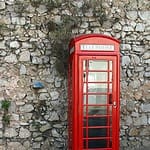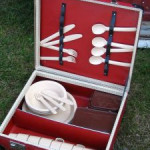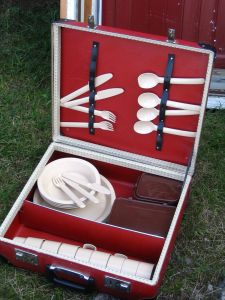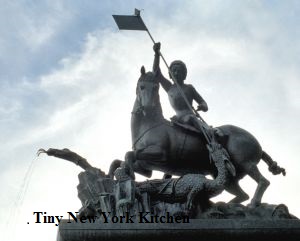Simnel cake is a traditional English fruitcake eaten during the Easter season and has been eaten since medieval times. The cake is both a rich, sweet treat and a symbolic ritual. The fruit cake is topped with eleven marzipan balls to represent the eleven apostles of Christ, minus Judas.
“Work With What You Got!”
©Tiny New York Kitchen © 2019 All Rights Reserved
Pumpkins earned their name because of their round shape. The English called them “pompons,” which came from the French word “pompom.”
Like many early American dishes, pumpkin pie is a product of indigenous ingredients and English culinary tradition. First cultivated in Central America around 5500 B.C., pumpkins were one of the first foods settlers brought back from the New World. The English quickly added pumpkin to their pie-making tradition, so by 1620, when the Mayflower sailed to the New World, it’s likely some of the Pilgrims were already familiar with these orange gourds.
There’s a very good chance that when the first Thanksgiving was held a year later, pumpkin was on the table in some form. By the early 18th century, Thanksgiving was a well-established holiday throughout New England, and pumpkin pie was part of the feast.
In 1705, Colchester, Connecticut, postponed Thanksgiving for a week, because there wasn’t enough molasses, their sweetener of choice, to make the pies.
“Work With What You Got!”
©Tiny New York Kitchen © 2018 All Rights Reserved
Chef Marco Pierre White (Great British Feast) Chapter 1
I love going on picnics, which take on many different forms for me. When I am in Europe on holiday I always find a local cheese shop and fill a basket with crusty bread, cheese, fruit, an assortment of sweets and sparkling water. I’ve been known to pull over while driving the English countryside and have a little picnic right there on the side of the road. However and wherever you decide to have a picnic it’s important to be Picnic Savvy.
Picnic Paraphernalia: Picnic equipment can be as simple as paper plates in a brown bag, or as elegant as a wicker hamper specially fitted with flatware and china. Picnic enthusiasts tend to accumulate equipment over a period of time, and to collect the supplies that suit the kind of picnicking they do most often. Let’s consider the paraphernalia you can use to transport, insulate, cook, and eat your picnic feast – whether it’s a backpacker’s basic lunch for two or a feast for eight.
For Transporting Food: If you’re not traveling far and your provisions aren’t perishable, you can carry your picnic in a brown grocery bag – that’s part of the casual spirit of picnicking. Buy why rough it, if that’s not your style? Other options offer you more packing space, easier carrying, better insulation, or simply more charm than any paper bag ever could.
Baskets: Import stores, gourmet shops, hardware stores, and gift emporiums carry baskets of straw, wicker, bamboo, woven rope, and even vinyl-covered steel wire. These baskets may be open or have hinged lids, and they may be lined with gingham or other brightly colored fabric. They may come empty or be outfitted with removable trays and/or picnic gear such as plastic plates, cups, flatware, and cloth napkins. The ultimate is an English picnic hamper – a large, costly wicker chest, its inside surfaces fitted with straps that hold a complete table service for several people.
When you’re shopping for a picnic basket, look for a sturdy, roomy one. If it has handles, they should be strong and durable, especially on larger models. Whether or not the basket should have a lid is a matter of personal preference. A lid can provide a handy cutting or serving surface, but food can be covered just as well in an open basket if you line the basket with a pretty tablecloth and then fold it over the contents when the basket is full. Try this technique, too, with a brightly colored plastic laundry basket and a tablecloth in harmonizing colors.
Coolers: For perishable picnic foods, a cooler (ice chest) is a better choice than a basket. Foods that spoil quickly, such as meats, fish, mayonnaise, and most dairy products, must be kept cool to prevent bacterial growth and the possibility of food poisoning. Even inexpensive Styrofoam coolers can keep foods fresh and cool for hours, though they’re less durable than insulated metal or heavy-duty plastic models.
When purchasing a cooler, look for sturdiness; strong, easy-to-hold handles; and tight lids that lock in place. Many coolers have lids that are hinged so they don’t blow away or get lost, or that they are indented to hold glasses. Some contain trays that keep food away from melting ice. Another useful feature is a leak-proof drain.
Besides the large chest style coolers, you’ll find newer, lighter models that are carried by one handle at the top, and smaller versions that you can carry with a strap.
Bags: Designed especially for carrying foods and beverages and keeping them cool, “refrigerator bags” are usually insulated with fiberglass, covered and lined with vinyl, and fitted with wraparound handles and a zipper that allows the flat top to be opened on three sides. I’ve also seen refrigerator bags with canvas exteriors rather than plastic.
You can use refrigerator bags for hot foods, too as they will maintain a given temperature for several hours. If hot food is in a very hot container – particularly glass or metal – you would be wise to protect the vinyl bag from heat by wrapping the container in newspaper first.
Nylon or canvas duffle bags used for sailing and for carrying athletic equipment also make good picnic carryalls. They are roomy and strong, with sturdy straps and reinforced bottoms. Fishing tackle bags are useful too.
You might also think about using old luggage for picnic toting. Anything from a small carry-on airplane bag to a large, lightweight suitcase may do beautifully. Backpacks are convenient carriers, too. A light day-pack works well for small meals, a larger frame pack for more ambitions picnic projects.
Any kind of cloth, straw, or woven bag may also fill your needs. Or you can simply wrap your picnic in a tablecloth or other ground cover, bring the corners together, and knot them, like a Japanese furoshiki. http://www.youtube.com/watch?v=b2suAPvcm6I. You can also use this technique with oversize cloth napkins for individual picnic meals.
April 23rd is the Feast of Saint George. For all of his popularity little is known about Saint George except that he was born in Cappadocia (Turkey), that he was a soldier and suffered martyrdom. The crusaders brought his fame to the West. He is the patron saint of England, Aragon, Portugal and certain parts of Germany. Before the Conquest many English churches had been named after Saint George and the story of his brave deeds were revered everywhere.
Saint George’s best known deed is legendary. Legend has it that he slayed a horrible dragon in order to save a maiden who had been vowed to a monster. The story goes that Saint George transfixed the dragon with a spear and then told the maiden to lead the monster around so that he could put an end to him. St. George was very well known by that time as a man of God and a confessor of His works. Apparently, after witnessing the miraculous slaying of the dragon, 20,000 people were converted to Christ. The king begged St. George stay in exchange for half of the kingdom. St. George refused the offer because he wanted to ride on and carry God’s message.
Saint George is especially honored in England as its great patron. Flags are flown on this feast day, but in earlier times this feast day was filled with more elaborate celebrations (processions, jousts & races). The dishes served on this day should be English favorites such as roast beef and Yorkshire pudding.
In Allier, a winegrowing region of France, there is an interesting observance of Saint George’s Day. If frost has not harmed the vines by this day then a clean, soft little towel is offered to the statue of the saint and his feet are washed in wine. There will be shouts of “Vive Monsieur Saint Georges.” If frost has harmed the vines, however, Saint George is not very popular and though his feet are still washed a rough, coarse cloth is used.
 Feast of Saint John The Baptist June 24th
Feast of Saint John The Baptist June 24th
One of the many unique things that we could say in describing St. John the Baptist is that he is truly the "Saint of Summer." Saint John the Baptist is one of the most important saints. Other than the Virgin Mary and St. Joseph, John the Baptist is the only saint who is honored on the Church calendar with more than one Feast Day (the other is August 29th, the day of his martyrdom). As we can see, both these Feast Days occur at the opposite ends of the Summer season. John the Baptist saw and lived very clearly his purpose in life and carried it out in the midst of challenges. He had two important qualities of his life that should inspire us each day.These two qualities are humility and a sense of purpose.
Son of Elizabeth and Zacharias, both already advanced in years and childless, John was born about 6 months before Jesus. This birth had been announced by the archangel Gabriel to Zacharias, who was struck dumb by the message. 8 days after the birth, having to be circumcised, the child needed a name, and Zacharias succeeded in writing “John,” following indications of the angel; his tongue loosened in the hymn of the Benedictus. In representations of the birth o the Baptist, Mary is usually also present, assist her cousin Elizabeth, while Zacharias is most often shown in the act of writing. The name John is from a Hebrew name meaning “Yahweh is gracious.”
This is a great feast of June that is common to countries and has been celebrated since early times, is the Nativity of Saint John the Baptist, also known as Midsummer. In lots of places bonfires are lighted in honor of Saint John. This day is to celebrate the summer solstice. In Ireland and in England these bonfires had their origin in the Druidic fires lighted in honor of the god of the sacred wood. Today they are known as the Fires of Saint John although a few pagan customs remain in connection with the celebration.
In France the bonfires are built as close as possible to one of Saint John’s own chapels. It is important to have a boy named Jean or a girl named Jeanne provides a wreath to throw into the fire. When vesper services are over the priest kindles the blaze and the evening begins with singing and dancing which will last far into the night.
In Mexico Saint John’s feast is a big affair. Saint John is the Mexicans dearly beloved saint, especially the saint of the waters. On this day wells and fountains are decorated bright with ribbons and flowers. At midnight on the eve, everyone bathes: in the country in lakes or pools or rivers; in large cities the festivities center around the fashionable bath houses where swimming contests and exhibitions of diving skill take place.
Saint John’s Day in Mexico is definitely also a day of feasting. Everyone brings food to the bathing places. Cakes, sweets, chicken tamales, stuffed peppers, pork tacos and empanadas.















